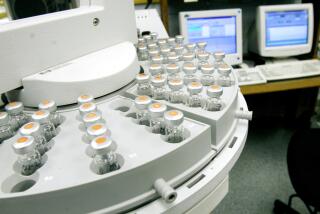Morgue Stands Ready to Give Names to the Dead
- Share via
ST. GABRIEL, La. — The grisly work of identifying the dead is almost ready to begin.
Inside a private warehouse in this tiny town, 65 miles northwest of New Orleans, the Federal Emergency Management Agency has established a makeshift mortuary.
A sign -- “Mortui Vivis Praecipiant,” Latin for “Let the Dead Teach the Living” -- hangs at the entrance to a long corridor that will become an assembly line of forensic investigation.
This will be a daunting job. Twelve stainless steel rolling tables are lined up at the entrance. They will carry the corpses over a floor lined with black plastic.
Photographs will be taken to catalog tattoos, surgical scars and personal belongings in hope of connecting each body to a name, an address, a family. Fingerprints, dental X-rays and DNA samples will be taken too.
But DNA tests require matching samples from relatives to identify the dead, and they may be difficult to obtain with so many evacuees scattered in shelters or living with families or friends across the country.
And matching dental records may be under floodwater or inaccessible.
An organized pickup of bodies began Monday, said Dr. Louis Cataldie, the Louisiana Department of Health and Hospitals official in charge of the effort.
The number of dead “one day, hopefully, will describe the scope of the catastrophe,” he said.
State officials said they had the capacity to handle up to 144 corpses a day at this facility, with enough refrigerated trucks available to store 5,000 bodies.
New Orleans officials have estimated that the death toll could reach that high or higher. People drowned in many parts of the city, and bodies will be difficult to identify after a week in fetid water.
Some bodies have already been collected: 28 have been gathered at a highway intersection in New Orleans; 29 are ready for pickup at the Jefferson Parish coroner’s office.
Twenty-three bodies are already stored in the refrigerated trucks next to the warehouse in St. Gabriel, a poor town of 5,000. Those 23 corpses will be the first to be processed.
Each body will start as a number on a loading dock. Each will be sprayed with a chlorine solution as a precaution against infectious diseases.
And each will be assigned an escort to wheel it through the process of collecting forensic evidence.
A staff of 90 morgue workers -- medical examiners and technicians who are part of the Disaster Mortuary Operational Response Teams -- should be able to determine the day of death, making it possible to know someday how many died in the storm itself and how many died in its aftermath.
But the vast majority of corpses will receive no autopsy.
That will be reserved for bodies with gunshot or stab wounds or other signs that the hurricane and subsequent flooding were not the direct cause of death. Those cases will become criminal investigations.
Cataldie, a former coroner, acknowledged that solving those crimes could be difficult.
“If the person is abandoned and in the water ... there is no crime scene,” he said.
The forensic data from all the corpses will be turned over to the state, which will be in charge of connecting the dead to their families.
Bodies that are not identified will be buried by the state, Cataldie said. And the DNA samples will be saved in case their families ever come forward.
More to Read
Sign up for Essential California
The most important California stories and recommendations in your inbox every morning.
You may occasionally receive promotional content from the Los Angeles Times.














